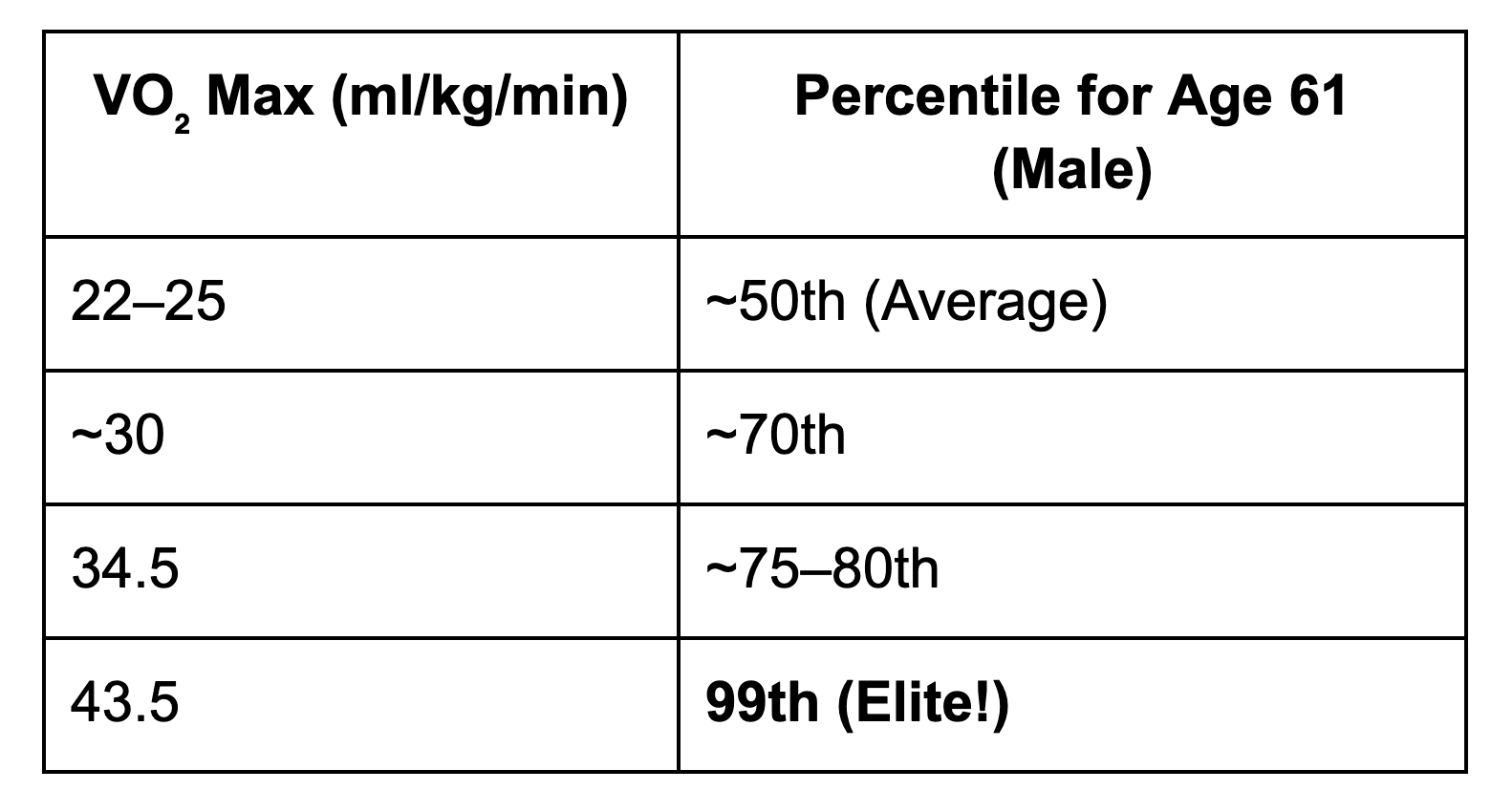From Fit to Elite: A 61-Year-Old’s Six Month Transformation
What happens when a 61-year-old man uses the exact right strategy and increases his VO₂ max over a 6 month period by nearly 10 full points — from an already respectable 34.5 ml/kg/min to an elite 43.5 ml/kg/min?
You don’t just get fitter and faster — you get younger on the inside, reduce your risk of nearly every chronic disease, and significantly boost your chance of living a longer, more energetic life. This isn’t just about athletic performance; it’s about survival and thriving.
VO₂ Max: The Life-Extending Metric
VO₂ max is the maximal amount of oxygen your body can use during intense exercise. It's one of the most powerful predictors of athletic performance and mortality. In fact, I strongly believe that cardiorespiratory fitness is superior to traditional risk factors like smoking, diabetes, or high cholesterol in predicting risk of disability and death from all causes.
Since he started at 34.5 and ended at 43.5, here’s what those VO₂ percentiles look like for our patient:
What Does This Improvement Mean for his Performance on the Triple Bypass?
This patient is training for the Triple Bypass, one of Colorado’s most iconic and grueling cycling events — 118 miles, over 10,000 feet of elevation gain, and three major mountain passes (Juniper, Loveland, and Vail). It demands not only endurance, but efficiency, power, smart pacing at altitude, and the right fueling strategy to avoid bonking.
Thanks to his VO₂ max and cardiovascular gains, this patient is now objectively proven to be far more capable of excelling at this kind of challenge.
Higher VO₂ Max = More Power for Longer
VO₂ max of 43.5 ml/kg/min puts him in elite territory — the level seen in well-trained endurance athletes.
This translates to more oxygen delivered to working muscles, more ATP production, and less lactate accumulation at a given effort.
He’ll be able to climb longer, ride faster, and recover quicker between ascents.
Rise Precision Medicine offers VO₂ Max testing. Click here to learn more and get scheduled.
Improved Anaerobic Threshold = More Speed Below the Red Line
By following the specific training prescription we provided based on his initial VO₂ testing, his anaerobic threshold jumped from HR 139 to 157 — meaning he can now ride at a much higher intensity while still relying primarily on fat oxidation and aerobic metabolism without building up lactate in his muscles.
This is key for long, sustained climbs — he’ll delay fatigue, spare glycogen, and reduce the need for excessive fueling during the ride.
4x More Fat Burn = Greater Metabolic Efficiency
Fat burn improved from 0.2 g/min to 0.8 g/min — a massive leap in metabolic flexibility.
That means he can ride at moderate intensity for hours using fat as a primary fuel source, reducing the risk of bonking and preserving high-octane energy for big climbs or surges.
VO₂ Pulse Gains = A Stronger, More Efficient Engine
VO₂ pulse increased from 19.4 to 22.1 ml/beat, indicating higher stroke volume and more oxygen delivered per heartbeat.
On steep climbs or at altitude, where heart rate rises quickly, this will allow him to stay calmer and more efficient, with lower heart rate drift and better output over time.
What Does his Improvement Mean for Mortality?
A 9-point increase in VO₂ max equals about 2.6 METs (1 MET ≈ 3.5 ml/kg/min). According to a 2018 study in JAMA Network Open, each 1 MET increase is associated with a 13–15% reduction in all-cause mortality.
That means with six months of training our patient has slashed his mortality risk by an estimated 35–40%.
VO₂ Pulse: A Younger, Stronger Heart
VO₂ pulse — calculated as VO₂ max divided by max heart rate — gives insight into stroke volume (how much blood the heart pumps per beat). It's a proxy for how efficiently your heart delivers oxygen.
Fat Burn: From Minimal to Metabolic Machine
Metabolic testing also showed a quadrupling of maximum fat oxidation:
Then: 0.2 g/min at heart rate 113
Now: 0.8 g/min at heart rate 135
That’s a 300% increase, and a huge leap in metabolic flexibility — the ability to efficiently burn fat during exercise. He now burns fat while producing WAY more power… and at a heart rate he can maintain for hours and hours.
His aerobic threshold (AT) also increased from HR 139 to 157, meaning he can perform at higher intensities while still using oxygen efficiently — a sign of elite endurance.
Zone 2 training (the “fat-burning zone”) shifted from HR 118–130 to HR 120–140, expanding the time he can spend in the sweet spot and the power at which he can ride and feel quite comfortable.
What It All Means
This isn’t just a case study in performance. It’s a blueprint for healthspan.
More energy and stamina for daily life
Sharper cognitive function
Lower risk of cardiovascular disease, diabetes, and neurodegeneration
Better recovery and lower inflammation
Living around 3-6 years longer with a higher quality of life
Take home: Fitness is Medicine
You might be interested to know that this patient also lost 22 pounds and reversed all signs of metabolic syndrome in the process. If you're in your 40s, 50s, or beyond, working to improve your VO₂ max is one of the most impactful changes you can make. And it's never too late. With consistent training — especially Zone 2 aerobic work, intervals, and strength training — your biology can change dramatically.
You don’t just feel younger. You become younger. Schedule your test here.


